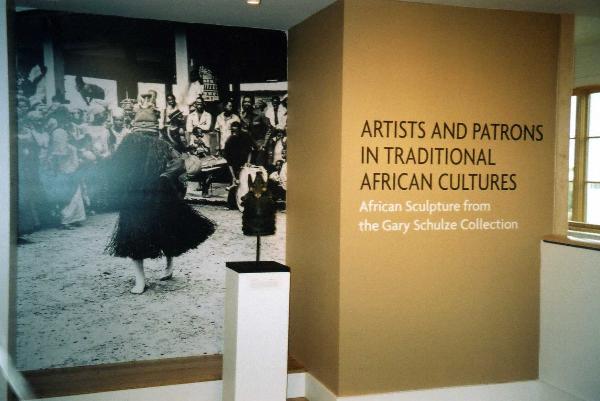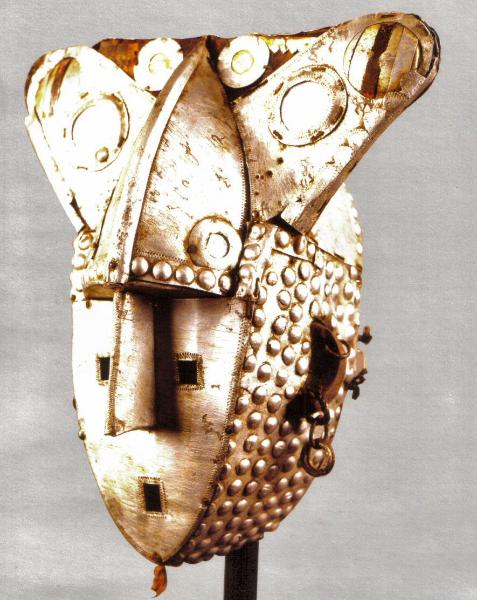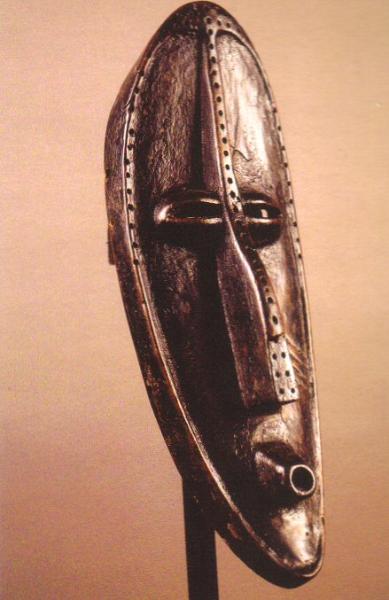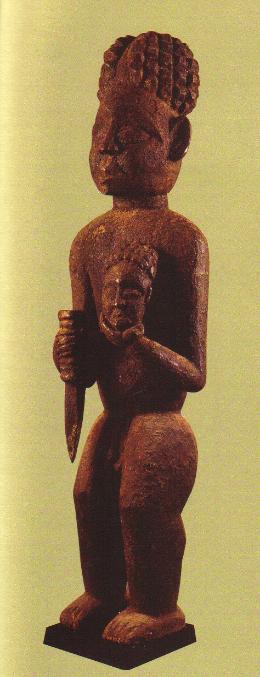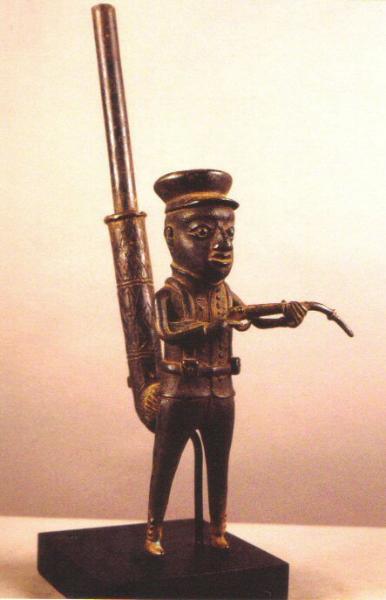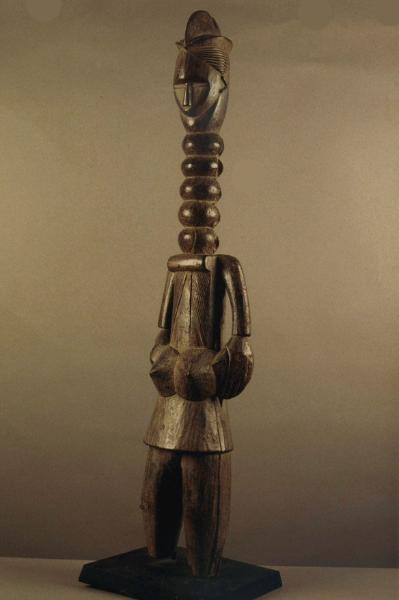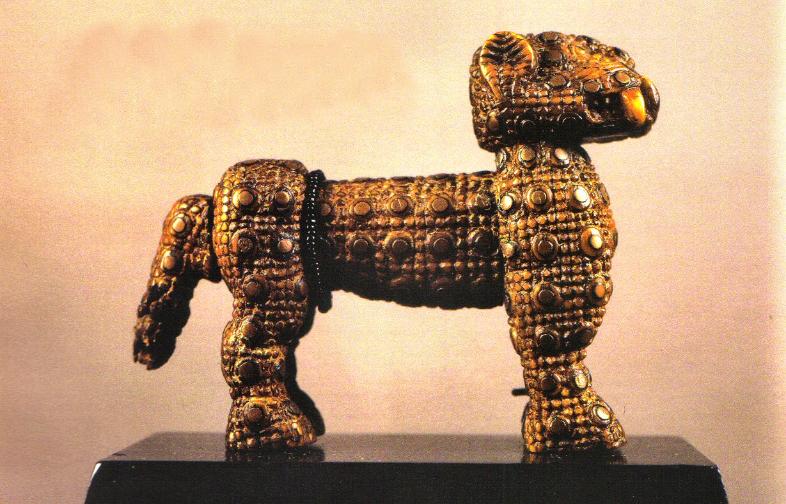| Artists and Patrons in Traditional African Cultures African Sculpture from the Gary Schulze Collection From the exhibition originally held at the QCC Art Gallery in 2005 Queensborough Community College, New York |
| Photograph of the entrance to the exhibition |
| Below are just a few objects from the wonderful catalog that accompanied the exhibition. The catalog contained many different examples from the exhibition and also contained a great deal of information on the objects, their uses and the cultures. It is a fantastic catalog in my opinion. |
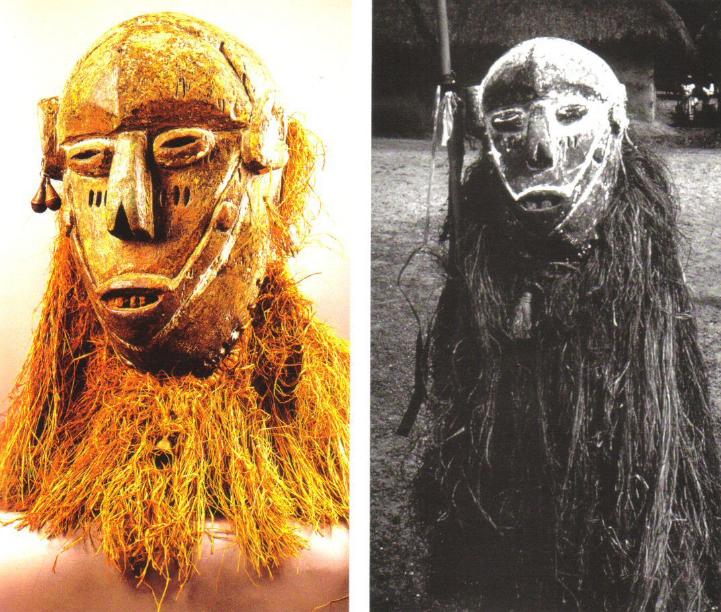
| Plate 8 Gongoli Mask, 24" Mende, Sierra Leone The Gongoli mask performed as a comic figure at village celebrations. Unlike other Mende masked characters which are silent, Gongoli speaks in a gravelly voice, mocking the chief and village elders. The mask has no sacred affiliations and can be carved and danced by anyone. Raffia, metal, white clay, red ocher and enamel are included in the materials used on this mask. Three 'tear' marks on either cheek act simultaneously as scarification and as viewing holes for the dancer. |
| Figure d. Mask in plate 8, worn by Gongoli Dancer. Moyamba District, Sierra Leone, 1962. |
| Female Figure, 15" Temne, Sierra Leone This idealized figure is similar to another in the British Museum, collected about 1900 (Ravenhill: "A 'Temne' Figure"), placing its cultural use to approximately the 1850's. Both figures, along with eleven others, have been attributed to the same artist working out of the Temne, Sherbro, Mende complex in the mid-1800's. The ringed neck, classic pose, coiffure and body scarification mark this figure as an initiated, mature woman. |
| Djankouran Koun Mask, metal-covered, 18" Malinke, Guinea Used by age-grade associations, this rare metal-covered mask replicates a type usually made of cloth, leaves and raffia. The mirrored circles at the top symbolize eyes. The mask thereby has the ability to seek out witches and sorcerers. (Imperato, R pc 5/16/96) |

| Plate II - Poro Face Mask with metal strips, 24" Toma, Liberia/ Guinea The Toma/Loma people occupy an area spanning the border of Liberia and Guinea. Male masking traditions center on Poro rituals. Typical of masks in this culture, the heavy brow and perpendicular nose form an abstract face. Magical ingredients are placed into the red cloth package at the top of the head. |

| Plate 12 - Poro (Lo) Mask with lobed top, 8 1/2" Senufo, Ivory Coast The Poro Society, called Lo among the Senufo, is the controlling agent for male Liberia masking traditions. Some masks were not worn but used inside the Society as spiritual intermediaries. This wooden mask still carries blood encrustation, the residue of sacrificial offerings. |
| Plate 15 Vertical Mask with 14 'eyes,' 22" Oubi/Grebo complex, Ivory Coast Seven pairs of solid, tubular eyes flank the median strip of this vertical mask. Actual viewing holes are pierced through the wood in a pattern on either side of the nose. A projecting mouth and a swelling at the forehead complete the mask's carved features. The eyes are pigmented with alternating white and red colors. Remains of feather quills may be seen at the top of the mask, and rim holes around the lower third served to hold raffia costume elements. This mask compares with the 12-eyed one in the Musee des Arts d'Afrique et d'Oceanie in Paris, alternately referred to as Grebo, Oubi or Kru. |
| Plate 16 Vertical Mask 28" Grebo or Oubi, Liberia/Ivory Coast Slightly concave, with tubular eyes and pierced viewing holes on either side of the nose, this mask is similar in shape to the previous one but differs from it in some details. It does not have multiple eyes. The projecting mouth is square in shape, with serrated teeth, and the top ridge shows no signs of feather-holes. The asymmetrical application of pigment is unusual. A mask similar to this, in the collection of the Metropolitan Musuem, has been identified as Grebo. These masks seem to originate in far southeastern Liberia or southwestern Ivory Coast, as part of the Kru/Grebo/Oubi complex near the Cavally River. |
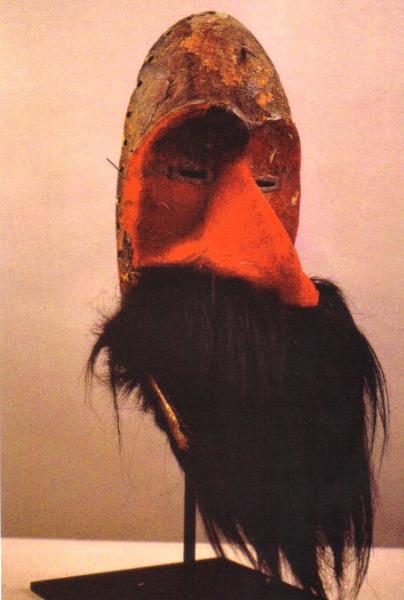
| Plate 18 Gagon Gle Mask with red cloth, 13" Dan, Liberia The term Gle applied to all masks in the Dan complex. Gle is the "invisible spirit that acts through [the] mask and the Gle Zo (the human being who is the Gle embodiment); the mask and the Zo should be considered as mere materializations of the Gle spirit." (Tabmen, p. iv) This gagon (masculine mask) represents the toucan, a hornbill bird found in northern Dan creation myths. (Fischer, E. "Dan Forest Spirits" African Arts I 1:2, p. 16) |
| Plate 20 Lozenge-shaped Mask, 15 1/4" MaHongwe (Kota), Gabon A sub-group of the Kota, the MaHongwe created wood masks that bore "strong resemblances to metal covered reliquary figures. These masks were apparently danced in some way." {Siroto, L. "Face of the Bwira" A/Horn Arts 1:3, p. 86) |
| Plate 22 Lobi Bateba Head, 20" Lobi, Burkina Faso/lvory Coast This fine, abstract head was once part of an ensemble which included an earthen body. The elongated neck was inserted into the clay to complete the figure, which portrayed a thil or beneficent ancestor. Thus the erosion on the lower part of the neck occurred as it was embedded in its earthen body. The ensemble resided in a shrine along with other figures and objects relevant to that spirit. They were believed able to exert influence for the benefit of their devotees. |
| Plate 24 Ifa Divination Tray, 12 3/4" diameter. Yoruba, Nigeria The head of Eshu dominates this circular board. The square, geometric patterning around the outer rim is interrupted by two kneeling figures making obeisance (dobale) to the Orisa. (Drewal, H. pc 4/1 1/00) Diviners who used such trays directed the carver in their making. |
| Plate 27 Bahouang (Bamileke Style) Royal figure, 39" Grassfields, Cameroon Memorial sculpture of a deceased ruler, shown with a knife in one hand and the head of an ancestor in the other. The headgear replicates the knobbed cloth cap worn by royalty. A covered niche carved in the back of the figure held powerful ingredients. The figure has an encrusted black surface. The figure probably marked the passing of a chieftancy from one generation to the next. |
| Plate 28 Male Royal Figure, 48" Dengese, Rep. of Congo In the Dengese culture, sculptures were carved for both male and female ancestors.This rare, royal figure, isikimanji, represents the power of kingship, passed to a new king upon his ascension. The protective gesture of the hands framing center of his body implies guardianship. Intricately carved patterning once covered the entire torso of the figure. The conical headdress is a sign of the highest status, thought to signify power and secrecy. A similar sculpture is found in the collection of the Royal Museum for Central Africa,Tervuren, Belgium. |
| Plate 33 - Oil lamp with multiple figures, 16", Baatombu (Bariba), Republic of Benin Among the Baatomba, the creation of pottery is the province of the women, who make both utilitarian and ritual forms. This oil lamp shows an array of female figures including a mother cradling her baby. Such lamps were commissioned for diviners or funerary rites. |
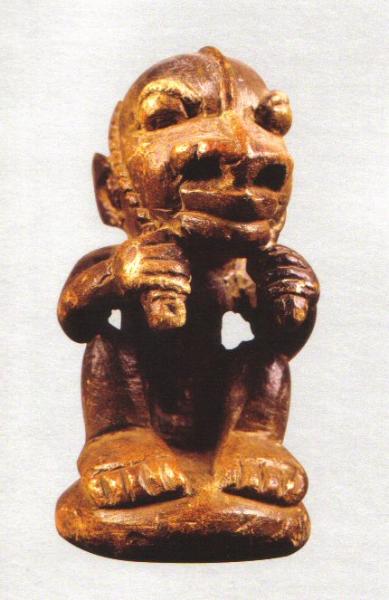
| Plate 35 Male Figure (nomoli), hands on beard, 7" Sape Confederation, Sierra Leone Steatite figures are found buried in the ground by farmers clearing land for new crops. Called nomoli by the Mende, they are placed in shrines and believed to be good omens. Holes in each ear of this figure connect, inside the head, with nostril holes and an opening in the top of the head. |
Plate 41 Plate 42 Plate 43
Plate 41 Trumpet with Female Figure, 21" Mende, Sierra Leone
Side-blown ivory trumpets have been used as insignia for paramount chiefs in Sierra Leone and Ghana. This trumpet is
ringed with bands carved in low relief and surmounted by a female figure with a head resembling those of Sande Society
helmet masks. Carvers of ivory were often woodcarvers who drew upon some of the same imagery in their creations.
Plate 42 Trumpet with Inscriptions, 25" Sherbro, Sierra Leone
The name Mustafa is scribed in Arabic. English letters name the paramount chief (PC) to whom the horn belonged. The
figure at the top wears a pith helmet and is seated on a chair carved in low relief. These trumpets were symbols of high
office and sometimes of a hereditary right to that position, since the horns were handed down from one generation to the
next.
Plate 43 Trumpet with Leopard, Hand and Tools, 23" Ewe, Ghana
In the lower band of this trumpet appear these words: dowoloa yawo awume kpndo abawn. A translation for this
publication reveals them to be a record of the carver's name and location. In phonetic Ewe, the carver identifies himself:
dowoloa (an artist or worker) named yawo awume (boy born on Thursday and father's name) from Kpando-abawan in
Ghana. (Translation by Father Tony Fevlo, Ewe member of Society of African Missions, pc Feb., 2004).
Plate 41 Trumpet with Female Figure, 21" Mende, Sierra Leone
Side-blown ivory trumpets have been used as insignia for paramount chiefs in Sierra Leone and Ghana. This trumpet is
ringed with bands carved in low relief and surmounted by a female figure with a head resembling those of Sande Society
helmet masks. Carvers of ivory were often woodcarvers who drew upon some of the same imagery in their creations.
Plate 42 Trumpet with Inscriptions, 25" Sherbro, Sierra Leone
The name Mustafa is scribed in Arabic. English letters name the paramount chief (PC) to whom the horn belonged. The
figure at the top wears a pith helmet and is seated on a chair carved in low relief. These trumpets were symbols of high
office and sometimes of a hereditary right to that position, since the horns were handed down from one generation to the
next.
Plate 43 Trumpet with Leopard, Hand and Tools, 23" Ewe, Ghana
In the lower band of this trumpet appear these words: dowoloa yawo awume kpndo abawn. A translation for this
publication reveals them to be a record of the carver's name and location. In phonetic Ewe, the carver identifies himself:
dowoloa (an artist or worker) named yawo awume (boy born on Thursday and father's name) from Kpando-abawan in
Ghana. (Translation by Father Tony Fevlo, Ewe member of Society of African Missions, pc Feb., 2004).
| Plate 53 Lightning Staff with Female Figure, bronze, 58" Mossi, Burkina Faso Staff finials were part of the regalia carried by blacksmiths and religious leaders. The images at the top served as insignia for each leader within a hierarchical society. (Roy, C- in Staffs of Life) |
| Pipe in form of German Soldier, bronze, 19" Bamum. Cameroon A fine lost-wax casting of a colonial German soldier shown with buttoned uniform, belt, ammunition boxes and a rifle. The cap of the figure opens into a pipe, the stem of which is patterned in interlocking lines. German occupation of the Cameroon grassfields lasted from 1902-15, at which time this casting was probably made. |
| Mende prestige figure 32" tall |
| From the Kingdom of Benin comes a rare ivory carving of a leopard. This miniature (4 1/2" long) is one of two known examples, the other of which is in the New Orleans Museum of Art. Both are believed to have been models for the large pair of ivory leopards given to Queen Victoria in 1897. That large pair, now in the British Museum, was constructed in a manner similar to this miniature leopard. Expert comparison of construction techniques for the large and small leopards produced the following observations: "The large leopard examined was constructed of five sections that are identical to the sections of the small leopard.. .Assembly is also achieved with ivory tangs and copper assembly pins ... The small ivory leopard was manufactured using sophisticated joining techniques that compare favorably to those used for the large leopards." A drawing of the construction of the small leopard (below) illustrates that each of the tangs fit into an adjoining section of the body, thus securing the parts. A connecting pin inserted down through its rump prevents the tail from coming loose. There was no practical need for such elaborate construction in a small object that could easily have been carved of a single piece of ivory. Piecing this object made sense if it were required to work out the problems associated with the larger leopards that, of necessity, had to be carved in pieces. Since the small leopard is so finely finished, with both copper and incised spots, it may also have acted as a presentation piece or gift. |
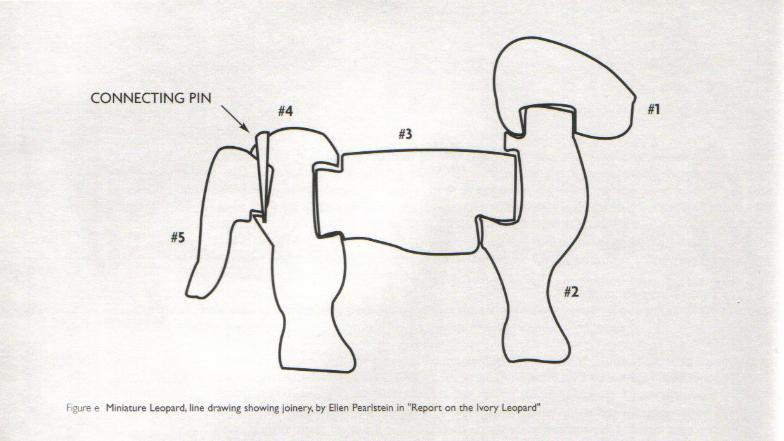
| Female Figure, 36" Nok culture, Nigeria The accouterments depicted on this figure replicate crafts such as beading, textiles and metalwork, all of which were practiced at the time this figure was made. Elaborate regalia is indicative of the high status of an individual. Figures from this culture have been dated from c. 500 BC to 500 AD. |
| Seated Hogon Figure, 34" Dogon, Mali This diviner priest is seated on a stool composed of circular disks connected by upright supports, alternately carved to include images of turtles and crocodiles, liminal creatures that inhabit two worlds, as does the diviner. Incised zig-zag patterning on the top ring of the stool refers to the serpentine path of Lebe, primordial ancestor and protector of the Hogon. (Griaule: Conversations with Ogotemmeli) The object across the lap of the figure may be a musical instrument, a metaphor for harmony. This seated figure is comparable to a smaller example in the Rockefeller Collection at the Metropolitan Museum of Art in New York which holds a calabash and striking stick. |
| Villagers attend the donation of their Sande Society mask to the Sierra Leone Museum, represented by Gary Schulze. Moyamba District, Sierra Leone, 1962. Dedicated to the late Kondeh Bundu of Waiama Village, Bumpe Chiefdom, Bo District and to the people of Sierra Leone, West Africa. |
| It is a privilege for the QCC Art Gallery-CUNY to present its inaugural exhibition of African sculpture from the collection of Gary Schulze, along with the publication illustrating it, Artists and Patrons in Traditional African Cultures. Mr. Schulze, as one of the primary supporters and contributors to the QCC Art Gallery Permanent Collection, has given us not only fine works of art but also the benefit of his long involvement with the art of Africa, particularly that of Sierra Leone where he served in the Peace Corps during the I960's. He subsequently began a collection that now spans several artistic media and hundreds of years of history. In viewing each artwork displayed here, we may, in imagination, participate in its creation, through appreciation of its particular form, color or material presence. The essay, by Donna Page, which accompanies this exhibition, facilitates this participation by describing artists' techniques and the variety of tools used for stone, ivory and wood carving, bronze casting and the formation of terracotta sculpture, as noted in the introduction by Leonard Kahan. The essay also explores the special relationship between the artist and his patron, as each brought certain demands to the creative process. The task of the artist was to satisfy the requirements of the patron, within defined traditional norms, yet show his skill and imagination in creating a dwelling place for a particular spiritual or secular entity. So, as we appreciate each work, let us also celebrate these artists and their sponsors, for allowing us to participate in these expressions of spirit and culture. The importance of African art has been universally recognized, from its inception and use within its culture to its considerable influence on the arts of the world in the 20th century. The strength of its symbolic and formal heritage will continue to be felt in time to come, and we hope that our permanent collection will provide an important and accessible pathway to this legacy. We are grateful to many contemporaries who made this exhibition possible. To those who have contributed their construction skills to this building and to others who have diligently carried out daily tasks toward the larger goal of creating a thriving, multifaceted gallery building, we offer our thanks. We extend special appreciation to the President of Queensborough Community College, Dr. Eduardo Marti, for his encouragement and steadfast support. Thanks to Gary Schulze for his long and patient commitment to this project; to Donna Page for her research and curatorial expertise; and to Leonard Kahan for his continuing advice and energy. We are deeply grateful to all of them for their confidence and commitment to this project. Faustina Quintanilla, Director The Art Gallery Queensborough Community College |

| The cover of the catalog for the exhibition. The catalog for the exhibition is wonderful and is nicely illustrated. The essay, by Donna Page, which accompanies this exhibition is wonderful and very thorough. It is helpful in describing artists' techniques and the variety of tools used for stone, ivory and wood carving, bronze casting and the formation of terracotta sculpture. The essay also explores the special relationship between the artist and his patron, as each brought certain demands to the creative process. The task of the artist was to satisfy the requirements of the patron, within defined traditional norms, yet show his skill and imagination in creating a dwelling place for a particular spiritual or secular entity. The exhibition catalog consists of approximately 84 pages with color and black and white photos with captions and a 40 page essay. The Essay “Carvers and Patrons: Patterns of Ownership in Traditional African Societies” will explore the manner in which art was created and possessed in local cultures. The essay will use examples from the collection to illuminate the nature of the artist/patron relationship. In contract to Western societies where art is most often owned by individuals, much African art is communally owned, by groups, or by members of age, grade and other societies. Objects owned in this way, hidden rather than displayed to be “brought out” only on special occasions, like initiations or other rites of passage. In addition to group ownership, patronage by royalty resulted in the creation of many objects, some of which are seen in this collection. Diviners also sometimes played a part in the commissioning of sculpture. This essay will explore the training of carvers in different localities, and the different patronage systems under which they worked. Copies of the catalog for the exhibition are still available. If you are interested in obtaining a copy of the catalog, CLICK HERE to email the current distributor for the catalog to get more information. |
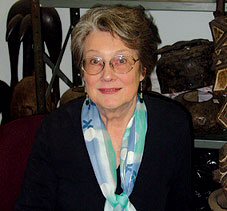
| The Author Donna Page has written several essays on the art of Africa, including “Two, Three, Four: Multiples in African Art” for Muhlenberg College (1987), and most recently “Keepers of the History” in African Art from the Collection of Dr. Michael Berger for the SMA Museum in Tenafly, N.J. (1997). She has been an adjunct in the Department of Art & Photography at Queensborough Community College since 1987. She is currently working on other catalogue essays including “Liberian Images” for the SMA Museum. |
| Artists and Patrons in Traditional African Culture main page |
| Rand African Art home page Museum and other exhibitions home page |
